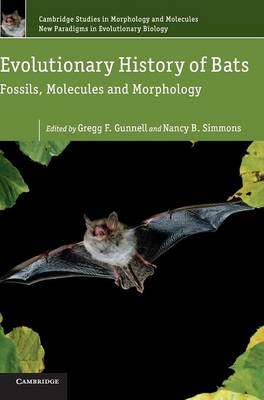
Evolutionary History of Bats
Cambridge University Press (Verlag)
978-0-521-76824-5 (ISBN)
Advances in morphological and molecular methods continue to uncover new information on the origin and evolution of bats. Presenting some of the most remarkable discoveries and research involving living and fossil bats, this book explores their evolutionary history from a range of perspectives. Phylogenetic studies based on both molecular and morphological data have established a framework of evolutionary relationships that provides a context for understanding many aspects of bat biology and diversification. In addition to detailed studies of the relationships and diversification of bats, the topics covered include the mechanisms and evolution of powered flight, evolution and enhancement of echolocation, feeding ecology, population genetic structure, ontogeny and growth of facial form, functional morphology and evolution of body size. The book also examines the fossil history of bats from their beginnings over 50 million years ago to their diversification into one of the most globally wide-spread orders of mammals living today.
Gregg F. Gunnell is an Associate Research Scientist and Vertebrate Collection Coordinator at the Museum of Paleontology, University of Michigan. He has spent the last 32 years studying the origin and diversification of modern mammals, mostly focusing on the fossil record and what it can tell us about these groups of organisms. Nancy B. Simmons is Curator-in-Charge of the Department of Mammalogy, American Museum of Natural History, New York. Her research focuses on the systematics and evolution of bats, including projects that range from higher-level phylogenetic studies to descriptions of new species. In 2008 she was awarded the Gerrit S. Miller Award from the North American Society for Bat Research.
List of contributors; Preface; 1. Phylogenies, fossils and functional genes: the evolution of echolocation in bats Emma C. Teeling, Serena Dool and Mark Springer; 2. Systematics and paleobiogeography of early bats Thierry Smith, Jörg Habersetzer, Nancy B. Simmons and Gregg F. Gunnell; 3. Shoulder joint and inner ear of Tachypteron franzeni, an emballonurid bat from the middle Eocene of Messel Jörg Habersetzer, Evelyn Schlosser-Sturm, Gerhard Storch and Bernard Sigé; 4. Evolutionary history of the Neotropical Chiroptera: the fossil record Gary S. Morgan and Nicholas J. Czaplewski; 5. New Basal Noctilionoid Bats (Mammalia: Chiroptera) from the Oligocene of Subtropical North America Nicholas J. Czaplewski and Gary S. Morgan; 6. Necromantis Weithofer, 1887, large carnivorous middle and late Eocene bats from the French Quercy Phosphorites: new data and unresolved relationships Suzanne Hand, Bernard Sigé and Elodie Maitre; 7. African Vespertilionoidea (Chiroptera) and the antiquity of Myotinae Gregg F. Gunnell, Thomas P. Eiting and Elwyn L. Simons; 8. Evolutionary and ecological correlates of population genetic structure in bats Kevin J. Olival; 9. A bird? A plane? No, it's a bat: an introduction to the biomechanics of bat flight Sharon M. Swartz, Jose Iriarte-Díaz, Daniel K. Riskin and Kenneth S. Breuer; 10. Toward an integrative theory on the origin of bat flight Norberto P. Giannini; 11. Molecular timescale of diversification of feeding strategy and morphology in New World Leaf-Nosed Bats (Phyllostomidae): a phylogenetic perspective Robert J. Baker, Olaf R. P. Bininda-Emonds, Hugo Mantilla-Meluk, Calvin A. Porter and Ronald A. Van Den Bussche; 12. Why tribosphenic? On variation and constraint in developmental dynamics of chiropteran molars Ivan Horáček and František Špoutil; 13. Necromantodonty, the primitive condition of lower molars among bats Bernard Sigé, Elodie Maitre and Suzanne Hand; 14. Echolocation, evo-devo, and the evolution of bat crania Scott C. Pedersen and Douglas W. Timm; 15. Vertebral fusion in bats: phylogenetic patterns and functional relationships Dawn J. Larkey, Shannon L. Datwyler and Winston C. Lancaster; 16. Early evolution of body size in bats Norberto P. Giannini, Gregg F. Gunnell, Jörg Habersetzer and Nancy B. Simmons; Index.
| Erscheint lt. Verlag | 29.3.2012 |
|---|---|
| Reihe/Serie | Cambridge Studies in Morphology and Molecules: New Paradigms in Evolutionary Bio |
| Zusatzinfo | 26 Tables, black and white; 8 Plates, color; 107 Halftones, unspecified; 26 Line drawings, unspecified |
| Verlagsort | Cambridge |
| Sprache | englisch |
| Maße | 175 x 246 mm |
| Gewicht | 1270 g |
| Themenwelt | Naturwissenschaften ► Biologie ► Evolution |
| Naturwissenschaften ► Biologie ► Genetik / Molekularbiologie | |
| Naturwissenschaften ► Biologie ► Zoologie | |
| ISBN-10 | 0-521-76824-1 / 0521768241 |
| ISBN-13 | 978-0-521-76824-5 / 9780521768245 |
| Zustand | Neuware |
| Haben Sie eine Frage zum Produkt? |
aus dem Bereich


